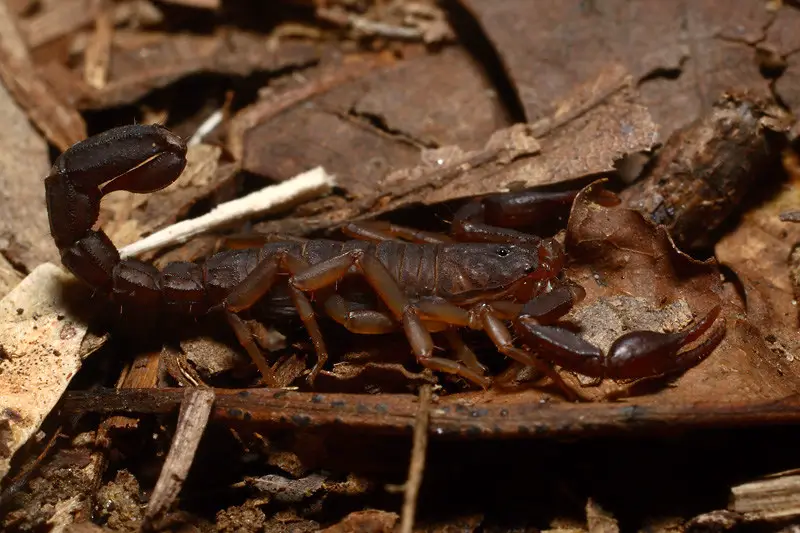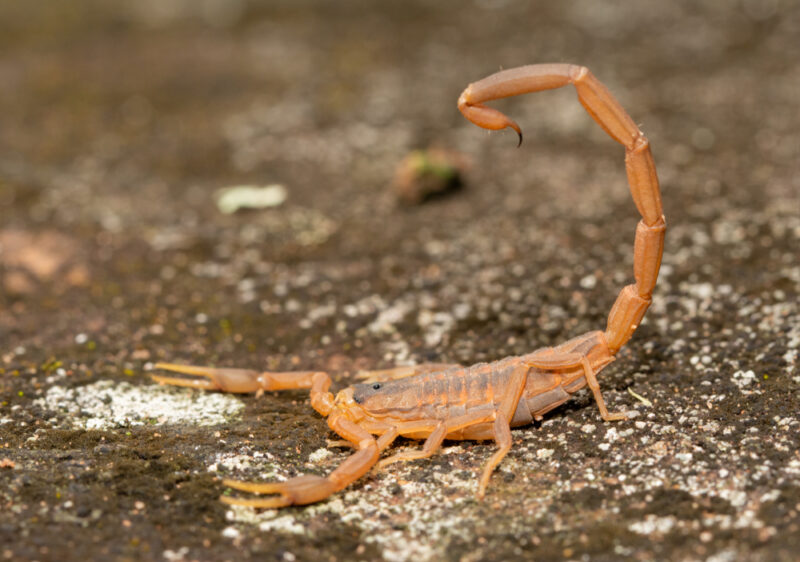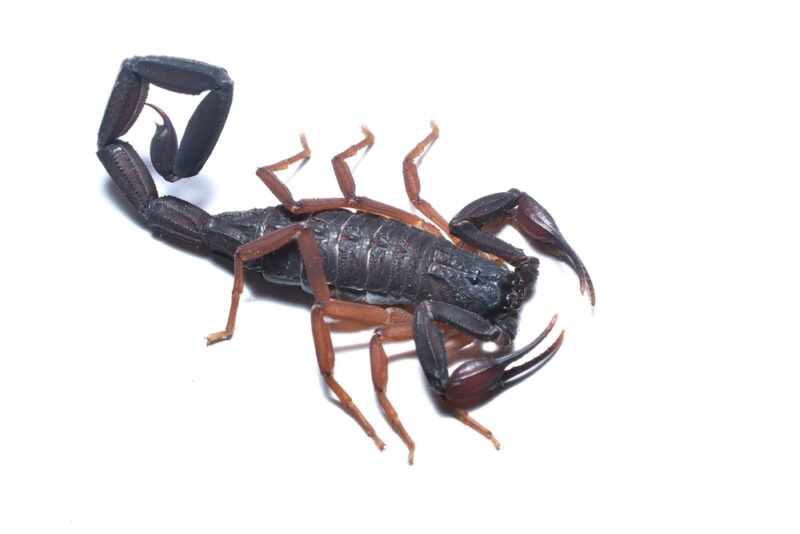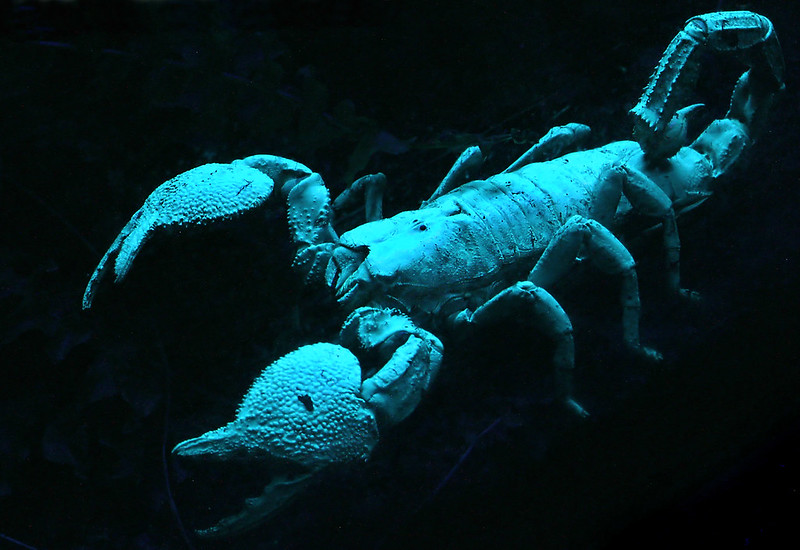The state of Georgia is home to 3 different species of scorpions. They are as follows:
- The Southern Devil Scorpion
- The Striped Bark Scorpion
- The Florida Bark Scorpion
Scorpions are arachnids, just as spiders are. All scorpions look a little bit like tiny land-dwelling lobsters with some distinctions. Lobsters have 10 legs, while scorpions have 8, and of course, lobsters don’t have a bulbous venomous stinger on the end of a narrow segmented tail, while scorpions do.
The good news is that the 3 scorpions that inhabit Georgia have stings that are no more medically significant than a bee sting. Nevertheless, in rare cases, the sting of a scorpion has the potential to cause a severe allergic reaction. Serious symptoms such as anaphylactic shock are a possibility. If you have blurred vision, muscle twitching, intense pain, or shortness of breath after experiencing a scorpion sting, seek immediate medical attention.
We’ll talk more about each of Georgia’s scorpions in the paragraphs below.

Southern Devil Scorpion (Vaejovis carolinianus)
The Southern Devil Scorpion goes by several different common names. People use them interchangeably, depending on the locality. Besides Southern Devil Scorpion, they are also called Southern Unstriped Scorpion, Southern Stripeless Scorpion, Carolina Devil Scorpion, and Plain Eastern Stripeless Scorpion.
Where do Southern Devil Scorpions Live?
People associate scorpions with the dry arid desert areas. The southwestern United States comes to mind. However, there are scorpion species that are adapted to live in warm, moist areas such as the southeastern United States. For instance, the Common Striped Bark Scorpion, the Florida Bark Scorpion, and the Southern Devil Scorpion are all examples of this.
Besides Georgia, Southern Devil Scorpions are native to all or parts of North Carolina, South Carolina, Florida, Tennessee, Louisiana, Virginia, West Virginia, Alabama, and Mississippi.
Southern Devil Scorpions prefer wooded areas in the mountainous regions of central and north Georgia, such as the Piedmont region and the Blue Ridge Mountains.
How Dangerous are Southern Devil Scorpions?
To quote University of Tennessee entomologist Karen Vail, “The Unstriped Scorpion is tiny, and its sting is usually harmless, but some people may have an allergic reaction to the venom if stung.” See
These scorpions pack a painful sting. Nevertheless, the venom of this species is not medically dangerous to normal healthy individuals. People who have been stung by one report that the pain intensity is very similar to a wasp sting.
However, as stated in the opening section, all scorpion stings have the potential to cause severe allergic reactions in some people. Click Here for the account of James Scully, who was a corporal in the 6th New York Cavalry of the Union Army during the Civil War. While encamped at Fair Oaks, Virginia, in 1862, Corporal Scully suffered a scorpion sting to the back of his neck and nearly died due to the severity of the reaction it produced.
The only native scorpion in the state of Virginia is Vaejovis carolinianus, or common name, the Southern Unstriped Scorpion. It’s the likely culprit that nearly killed Corporal Scully.
What do Southern Devil Scorpions look like?
Southern Devil Scorpion adults are typically 1 to 1 1/2 inches (25.4 to 38.1mm) in length. However, larger specimens grow up to three inches (76.2mm) long. In color, they have either a reddish or dark brown color.
Southern Devil Scorpion Behavior
Southern Devil Scorpions are nocturnal animals. During the day, they take shelter under loose stones, under loose bark, and beneath leaf litter or pine straw in the forest and your yard.
Around your house, you might encounter these little scorpions in a crawl space, beneath leaf piles or wood piles, in laundry rooms, or even inside one of the garden gloves that you accidentally left outside overnight. If you’re camping in their native areas, be sure to double-check your shoes, your sleeping bag, clothing, and any other possible hiding place that these scorpions might utilize. Luckily, they are very skittish and would rather hide from you than sting you. The only way you’ll ever be stung by one is through accidental contact.
They only use their stinger for defense or to subdue their prey. Their prey, by the way, consists of small insects and arachnids, such as spiders and other scorpions.

Common Striped Bark Scorpion (Centruroides vittatus)
Striped Bark Scorpions, which also go by the common names Plains Scorpion, Wood Scorpion, or Stripe Backed Scorpion, are the most common species of scorpions in the continental United States. Thousands of people are stung by them each year when they step on them with bare feet or come into accidental contact with them in some other manner.
Where Do Striped Bark Scorpions Live?
The range of the Striped Back Scorpion begins in the northern Mexico states of Chihuahua, Coahuila, Nuevo Leon, and Tamaulipas. It then extends northward up to the southern counties of Nebraska. Their range also extends longitudinally from the Sangre de Cristo mountains and Rio Grande of New Mexico in the west to the Missouri River and the Mississippi River in the east. The following U.S. states have populations of Striped Bark Scorpions: Arkansas, Colorado, Kansas, Illinois, Louisiana, Mississippi, Missouri, Nebraska, New Mexico, Oklahoma, Florida, Georgia, and Texas.
During the day, they will take shelter in a variety of hiding places, such as under boards, loose stones, and loose bark, on trees or logs. They also like manmade structures such as crawl spaces, attics, wall voids, wood piles, etcetera.
In areas with colder wintertime temperatures, Striped Bark Scorpions survive by tolerating limited freezing of their body tissue. These scorpions then hibernate through the months of cold weather in clusters of multiple scorpions.
What do Striped Bark Scorpions look like?
Adult Striped Bark Scorpions are up to 2 3/4 inches (69.8mm) long. An adult of this species is uniformly pale yellow in color, with the exception of two longitudinal dark stripes that run the length of its back and a dark triangle at the top of the head. Bark scorpions have the ability to turn their tail to the side to lie flat, which allows them to fit into small cracks.
Striped Bark Scorpion Behavior
Unlike Northern Scorpions and Northern Black Hairy Scorpions, which never venture far from their burrows, Striped Bark Scorpions are wandering nocturnal hunters. Like all bark scorpions, they are natural climbers. Besides living under rocks, they climb trees and fence posts and have no problem climbing the walls of your home in search of prey. They actually have a negative geotaxis, or in other words, they prefer an upside-down orientation. See
How dangerous are Striped Bark Scorpions?
According to the book, “The Biology of Scorpions” by Gary A. Polis, there are over 1,500 species of scorpions in the world. Of these, fewer than 25 have stings that are lethal to humans. What’s more, all of the deadliest scorpions are members of the Buthidae family. For example, in North America, we have the Arizona Bark Scorpion. This buthid scorpion lives in the southwestern United States and northern Mexico and is on the list of the most dangerous species of scorpions.
Like Arizona Bark Scorpions, Striped Bark Scorpions are members of the Buthidae family. However, even though they pack a painful sting, it is not nearly as dangerous as that of their close relatives. Instead, it is more on par with the seriousness of the sting of a honeybee. It’s important to remember, though, that despite the fact that the Striped Bark Scorpion’s sting is fairly innocuous to most people, in certain individuals, it can produce serious reactions.
In fact, in 2014, a Kansas teenager from Haysville who had been playing frisbee golf ended up spending 3 days in intensive care after being stung by what was most likely a striped bark scorpion that had been hiding in his shoe. See

Florida Bark Scorpion (Centruroides gracilis)
The third species of scorpion we’ll talk about is the Florida Bark Scorpion. This scorpion also goes by the common names Slender Brown Scorpion and Brown Bark Scorpion. Like all bark scorpions, it is a member of the
The Florida Bark Scorpion is rare in the peach state. It lives mainly in south Georgia in the counties bordering Florida. This Scorpion is actually not a native scorpion species to the United States. The most likely way that it arrived here from the tropics is by hitching rides on boats. See Florida Bark Scorpions are a native species in Mexico, Honduras, Belize, and Honduras. It is an introduced species in the United States, Cuba, Panama, Columbia, Ecuador, Jamaica, in the western hemisphere. In Africa, it has accidentally been introduced to Cameroon, Gabon, and the Canary Islands See
What do Florida Bark Scorpions Look Like?
Male Florida Bark Scorpions measure 1.97 to 6 inches (50-153mm), while female Florida Bark Scorpions measure 2.36 to 3.94 inches (60 to 100mm) See Also See
Florida Bark scorpions are variable in color. They may be reddish brown or black with reddish pincers. They are also sometimes dark brown with yellowish legs, reddish pincers, and black tail sections.
Are Florida Bark Scorpions Dangerous
Although they are Buthid scorpions, their venom is not considered to be dangerous. Consequently, the research into this species up to now has been minimal. See

How to look for Scorpions
As stated above, scorpions are nocturnal creatures. During the day, they hide out. Crawl spaces, wood stacks, rocky hillsides, and leaf-covered areas are all examples of likely hiding spots.
The best way to detect the presence of scorpions, though, is to search for them after dark.
Scorpions have compounds in their exoskeletons that glow under black light. To see them after dark, in your yard, or if you are camping in an area where scorpions are active, the best way to find them is with a UV flashlight. Use the ultraviolet light to scan your yard or campsite after dark. The scorpions will glow a bright blueish color.
Remember that the darker the night, the more the scorpion will glow. In other words, they are more luminous on a night of a new moon, for example. What’s more, campfires and other sources of light will cut down on the effectiveness of your ultraviolet light source.
One last thing to remember on this subject is that UV light radiating in the 320 to 400 nm range isn’t overly harmful to your vision. However, if you choose to use a UV light source that produces shorter wavelengths, you’ll want to also use eye protection.
Fun Fact
Even fossilized scorpions glow under ultraviolet light.
Treatment for scorpion stings
- Clean the sting site with mild soap and water.
- Apply a cold pack to the affected area.
- Avoid eating or drinking if you are having trouble swallowing.
- Treat with an over-the-counter pain reliever as needed.
- Make sure that the affected individual’s Tetanus vaccination is up to date.
- If any of the severe symptoms described in the above paragraphs are manifest, seek immediate medical attention. See
Recent Posts
The only venomous snakes in Washington State are Northern Pacific Rattlesnakes. The Northern Pacific Rattlesnake (Crotalus oreganus oreganus) is a sub-species of the Western Rattlesnake. Anyone...
Skunks are not classified as true hibernators. But they go into a state of torpor when the weather gets cold. Skunks are light sleep hibernators, along with opossums, bears, and raccoons. ...

